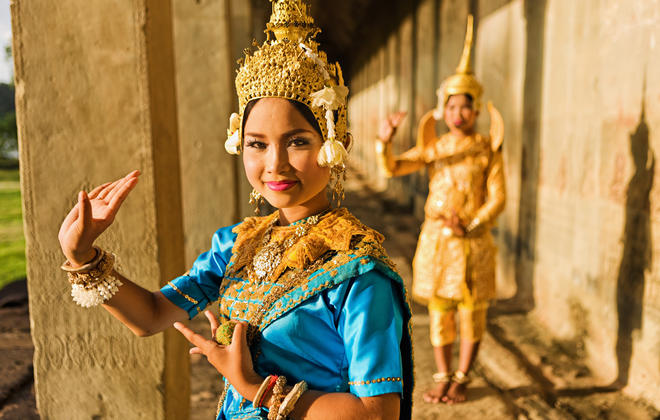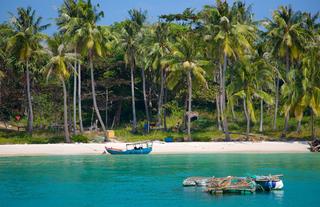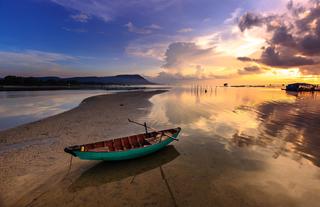Since reopening to tourists in the early 1990s, Cambodia has captivated visitors from around the globe with its rich cultural heritage, warm and welcoming people, and extraordinary natural wonders. Phnom Penh, the nation’s vibrant capital, pulses with energy, offering world-class dining, lively markets, and a spirited nightlife. Yet the country’s true treasures lie beyond the city: the sleepy, French-influenced town of Kampot enchants with its riverside promenade, colonial villas, and charming cafés; the lush, jungle-clad Cardamom Mountains reveal spectacular waterfalls and pristine wilderness; and, of course, the majestic Angkor Wat complex stands as the world’s largest and most breathtaking religious monument. Cambodia seamlessly caters to every traveller, whether seeking exhilarating jungle adventures, serene golden-sand beaches, luxurious resorts, or a journey through its tantalising local cuisine. With its blend of history, nature, and culture, Cambodia remains a destination of endless discovery and wonder.
Situated at the confluence of the Mekong and Tonle Sap rivers, Phnom Penh, Cambodia’s vibrant capital, captivates with its rich history, welcoming locals, and thriving culinary scene. The city’s heritage is immediately evident: the National Museum of Cambodia showcases over a millennium of Khmer art and design, while the monumental Royal Palace—home to King Sihamoni—features the iconic Throne Hall and the dazzling Silver Pagoda, whose floor gleams with five tons of silver. Along the Tonle Sap riverfront, visitors can enjoy refined dining and French-inspired wines, a legacy of the city’s colonial past, while the evenings come alive with lively nightclubs, karaoke performances, and stage shows. Combining culture, history, and cosmopolitan energy, Phnom Penh offers a dynamic and immersive Cambodian experience.





Vietnam is a land of breathtaking contrasts and sensory delights. It is a country that features everything from exotic culinary delights to breathtaking scenery. Seemingly endless, tranquil rice paddies stand in stark contrast to bustling cities such as Ho Chi Minh City and Hanoi which embrace all the technology and conveniences that the modern world has to offer. The well-preserved colonial buildings of Hoi An play host to a slew of charming boutiques and tempting cafes while, further north, the local hill-tribe people of Sapa sell a wide variety of exquisite crafts and handmade trinkets. Beyond the urban areas, this diverse country is characterised by vast, verdant jungles and lush mountainous regions as well as an enticing coastline peppered with golden sand, palm-lined beaches.
On the surface of it, the An Giang Province's Chau Doc may be a convenient one-night stopover en route to Cambodia, but if you find yourself in this charming town, you will do well to linger for a while. It is colourful, unspoilt, friendly, and rich in cultural diversity – clearly apparent in the numerous mosques, temples, churches and pilgrimage sites of the area. An excursion up Sam Mountain to view the shrines and places of worship, including the treasured Ba Chua Xa temple, should be on your to-do list, along with a visit to Tra Su Bird Sanctuary, which boasts a 23 metre-high observation tower. Afterwards, settle back and enjoy dinner at one of the superb eateries in town.





Situated on the south bank of the Hau River in the Mekong Delta or ‘nine dragon river delta’, Can Tho offers an interesting blend of rural peace and a gently developing urban infrastructure. Catch some of the buzz at the lively waterfront, or stroll through the narrow backstreets to discover exquisite sculptured gardens and Buddhist pagodas. The city is known for its many canals weaving through and out of the city. On your boat ride, visit the floating market for an authentic experience, including a taste of exotic local fruit.



Phu Quoc, Vietnam’s largest island, lies in Kiên Giang Province and is a tropical paradise that feels worlds away from the mainland. Visitors are greeted with miles of palm-fringed white-sand beaches, turquoise bays, and a lush, jungle-clad interior. Adventure and relaxation abound: dive or snorkel vibrant coral reefs, kayak through secluded coves, cycle along scenic backroads, or hike through the majority of the island protected as a national park, teeming with wildlife. Phu Quoc is also famed for its local specialities, including fish sauce, black pepper, and the unique Phu Quoc hunting dogs, known for their ridged backs, curly tails, and striking blue tongues, adding a distinctive cultural touch to this idyllic island escape.





Ho Chi Minh City, Vietnam’s electrifying southern metropolis formerly known as Saigon, brims with a restless energy that’s impossible to resist. The city is a kaleidoscope of sights, sounds, and flavours: the chaotic charm of Ben Thanh Market, where vendors peddle everything from exotic spices and street snacks to tailor-made suits; the leafy oasis of Nha Hang Ngon, serving traditional Vietnamese cuisine in a garden setting; and the lively cafes, rooftop bars, and art galleries that pulse through the districts, offering endless opportunities to soak in the city’s contemporary vibe. History and culture are never far away—admire the neo-Romanesque Notre-Dame Basilica, explore the carved statues at the Jade Emperor Pagoda, reflect at the War Remnants Museum, or visit the rare Taoist sanctuary of Khanh Van Nam Vien Pagoda. From bustling streets and hidden alleys to stylish nightlife and live music, Ho Chi Minh City is a constantly evolving urban playground where every corner offers a new adventure.











